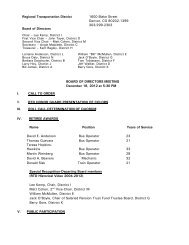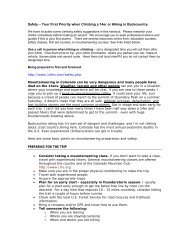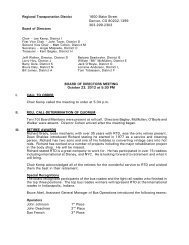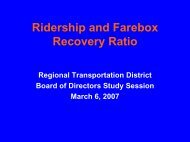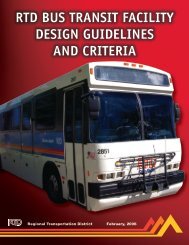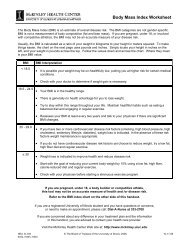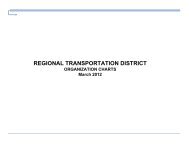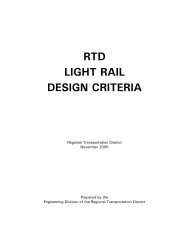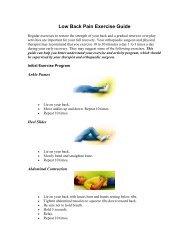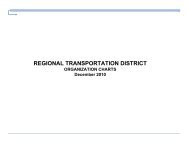Commuter Rail AC Electrification Load-Flow Simulation Report - RTD
Commuter Rail AC Electrification Load-Flow Simulation Report - RTD
Commuter Rail AC Electrification Load-Flow Simulation Report - RTD
You also want an ePaper? Increase the reach of your titles
YUMPU automatically turns print PDFs into web optimized ePapers that Google loves.
<strong>Commuter</strong> <strong>Rail</strong> <strong>AC</strong> <strong>Electrification</strong> <strong>Load</strong>-<strong>Flow</strong> <strong>Simulation</strong> <strong>Report</strong> Revision 1<br />
4.0 STUDY METHODOLOGY<br />
4.1 COMPUTER SIMULATION SOFTWARE USED<br />
The train operations and load-flow simulations were performed using computer software RR<br />
Version 13. The RR software was developed by LTK Engineering Services (LTK) specifically to<br />
perform traction power studies and is a comprehensive software tool used for design and<br />
analysis of both DC and <strong>AC</strong> traction power systems. RR was developed by identifying key<br />
elements which exist in other traction power simulators. These elements were improved where<br />
necessary (i.e. train dispatch file) and combined with a highly accurate method for modeling<br />
vehicle performance and power/voltage/current requirements into one comprehensive tool. The<br />
program is written in C++ and is Microsoft Windows-based with many user definable features,<br />
including customizable vehicle performance parameters.<br />
LTK’s traction vehicle/electrical system simulation software is unique in the industry in several<br />
respects. The performance of each train in the model is dynamically determined by the<br />
continuously varying voltage at the trains during the simulation, as occurs in the real world.<br />
Therefore, the program accurately models the tractive effort and current curves for the desired<br />
vehicle and automatically adjusts these curves as the traction power voltage varies along the<br />
traction power distribution system. This software also allows the simulator to model very<br />
accurately modern <strong>AC</strong> drive systems which include automatic, voltage dependent current or<br />
tractive effort limitations or adjustments, including detailed modeling of vehicle regeneration.<br />
The RR model can represent one or more “routes” on which trains run. A route consists of one<br />
or more track segments on which the trains will operate under different operational criteria such<br />
as headway, train length, acceleration, deceleration and speed limits. In general, trains on each<br />
route operate independently of other routes in the model, except for the voltage dependency<br />
mentioned earlier. Any electrical connections between the route power supplies or distribution<br />
systems feeding more than one route are correctly represented.<br />
The program produces a wide array of color graphical outputs, which aid in the analysis of the<br />
traction power system by visually displaying the data rather than printing the data in tabular<br />
form. The output charts and graphs include the following:<br />
• Train tractive effort and current vs. speed<br />
• Train speed vs. time and distance<br />
• String charts for each route<br />
• Train voltage profile for each route<br />
• Substation power demand and energy consumption for each substation<br />
• Substation instantaneous power for each substation<br />
• Substation average power over pre-defined time intervals for each substation<br />
• Feeder/catenary RMS currents<br />
Other important features include multi-route simulation and per-train scheduling. There is no<br />
limit to the number of routes, or train types. All output is graphical and is produced directly by<br />
the program without external software or manual effort. The simulator uses modern equation<br />
solution methods (i.e. spare matrix techniques and direct inversion of matrixes), is very fast and<br />
accurate, and very large and complex models can be simulated with ease.<br />
02/27/2009 FRSC Page 13 of 250




